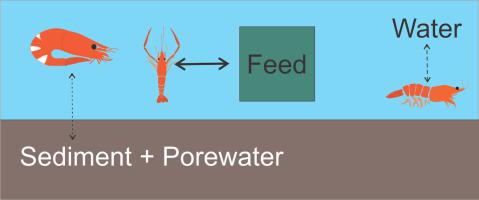Science of the Total Environment ( IF 9.8 ) Pub Date : 2021-05-15 , DOI: 10.1016/j.scitotenv.2021.147777 Matthew Dietrich 1 , John Ayers 1

|
Limited work has been conducted on trace metal(loid) exchange between sediment, water, feed, and shrimp, particularly in estuarine aquaculture environments. To identify metal(loid) sources and the processes controlling bioaccumulation in shrimp, we analyzed paired aquaculture water, sediment, and shrimp samples collected in Southwest Bangladesh in the late dry season (May), as well as several common artificial feeds. Additionally, we analyzed sediment extract samples from 24-hour laboratory batch experiments as an analogue for aquaculture pond sediment porewater to examine element mobilization from pond sediment. Weak correlations between element concentrations in extracts, pond water, and bulk sediment indicate equilibrium with sediment was not achieved in extract experiments or ponds, and that sediment composition has little influence on pond water or shrimp composition. Aquaculture shrimp metal(loid) concentrations were similar to artificial feed but not pond sediment or pond water, suggesting that shrimp composition is mostly influenced by diet. Although arsenic (As) and selenium (Se) were present at high concentrations in shrimp pond waters and sediment, they were often below detection in shrimp. However, the highly toxic metal thallium (Tl) was detected in shrimp at levels that pose significant human health risks based on calculated target hazard quotient (THQ) values. Thus, further research into potential Tl contamination in Bangladesh aquaculture environments is warranted.
中文翻译:

水产养殖虾池内的地球化学划分和可能的重金属(胶体)生物富集
在沉积物,水,饲料和虾之间的痕量金属(类)交换方面所做的工作有限,特别是在河口水产养殖环境中。为了确定金属(类)源和控制虾生物富集的过程,我们分析了在旱季后期(5月)在孟加拉国西南部采集的成对养殖水,沉积物和虾样本,以及几种常见的人工饲料。此外,我们分析了24小时实验室分批实验的沉积物提取物样品,作为水产养殖池塘沉积物孔隙水的类似物,以检查池塘沉积物中的元素动员。提取物,池塘水和大量沉积物中元素浓度之间的相关性较弱,这表明在提取物实验或池塘中未实现与沉积物的平衡,沉积物的组成对池塘水或虾的组成影响很小。水产养殖虾的金属(胶体)浓度与人工饲料相似,但与池塘的沉积物或池塘的水不同,这表明虾的成分主要受日粮的影响。尽管虾池水域和沉积物中的砷(As)和硒(Se)浓度很高,但虾中的砷和硒含量经常低于检出率。但是,根据计算得出的目标危险商(THQ)值,在虾中检测到剧毒金属th(Tl),其含量对人体健康构成重大威胁。因此,有必要进一步研究孟加拉国水产养殖环境中潜在的T1污染。这表明虾的成分主要受饮食影响。尽管虾池水域和沉积物中的砷(As)和硒(Se)浓度很高,但虾中的砷和硒含量经常低于检出率。但是,根据计算得出的目标危险商(THQ)值,在虾中检测到剧毒金属th(Tl),其含量对人体健康构成重大威胁。因此,有必要进一步研究孟加拉国水产养殖环境中潜在的T1污染。这表明虾的成分主要受饮食影响。尽管虾池水域和沉积物中的砷(As)和硒(Se)浓度很高,但虾中的砷和硒含量经常低于检出率。但是,根据计算得出的目标危险商(THQ)值,在虾中检测到剧毒金属th(Tl),其含量对人体健康构成重大威胁。因此,有必要进一步研究孟加拉国水产养殖环境中潜在的T1污染。根据计算出的目标危险商(THQ)值,在虾中检测到剧毒金属th(Tl),其含量对人体健康构成重大威胁。因此,有必要进一步研究孟加拉国水产养殖环境中潜在的T1污染。根据计算出的目标危险商(THQ)值,在虾中检测到剧毒金属th(Tl),其含量对人体健康构成重大威胁。因此,有必要进一步研究孟加拉国水产养殖环境中潜在的T1污染。



























 京公网安备 11010802027423号
京公网安备 11010802027423号